Design and innovation are continuously evolving, making journey mapping an essential tool. However, a journey map has transcended beyond just being a diagram (and was it ever just that?). It now serves as a catalyst that unites teams and fosters new ideas. Jim Kalbach, known for his book "Mapping Experiences," talked about this change at our recent event. Jim sees journey maps as gathering points, like campfires, where teams can share ideas and insights.
This article looks into journey map activation, a way to use these maps as starting points for finding new opportunities and sparking creativity. Read it or watch the recording of the event with Jim at the end of the article.
Mapping experiences
Initially, nearly a decade ago, the conversation around customer journey and experience maps centered on their basic definitions and creation processes. Today, the prevailing questions have shifted towards the practical application of these maps: How can they drive innovation? How can they help teams uncover new opportunities?
How to understand customer experiences
Designing for complex human experiences filled with varied emotions and needs has led to innovative practices like service blueprinting and customer journey mapping. These tools enable a deep dive into customer experiences, guiding businesses to adapt their services and products more closely to user needs. Central to this approach is recognizing the importance of understanding the customer experience to appropriately apply technology, moving away from a technology-first mindset.
This customer-centric perspective has catalyzed the adoption of mapping techniques to visually articulate and discuss experiences, with the service blueprint standing out as a prime example.
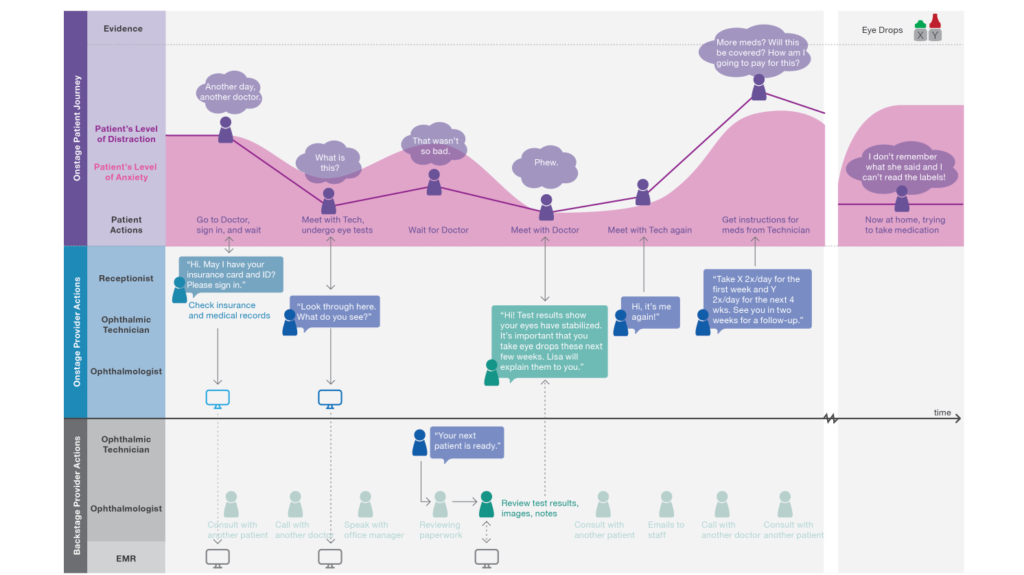
Such blueprints detail the customer's journey, including their actions, thoughts, and emotions, while mapping out the operational processes that underpin these experiences. They reveal the "backstage" activities, invisible to customers, like administrative tasks or preparation of medical equipment, emphasizing the seamless integration needed between customer experiences and organizational operations.
These tools align the delivery mechanisms — people, processes, or technology — with the customer's journey. This alignment ensures every element of the service is in sync with the customer's needs, enabling efficient and effective service delivery. The visualization offered by journey maps and service blueprints fosters a collective understanding among team members, bridging different perceptions and aligning them towards a unified goal.
Highlighting the importance of an "outside-in" approach, these mapping practices prioritize starting with the customer's perspective and then integrating technology to enhance that experience. This method contrasts with traditional approaches, encouraging a shift from focusing on internal processes to centering on the customer's needs. However, the ultimate value of journey maps extends beyond their creation. They are not meant to be static decorations but dynamic tools that facilitate continuous team improvement and alignment.
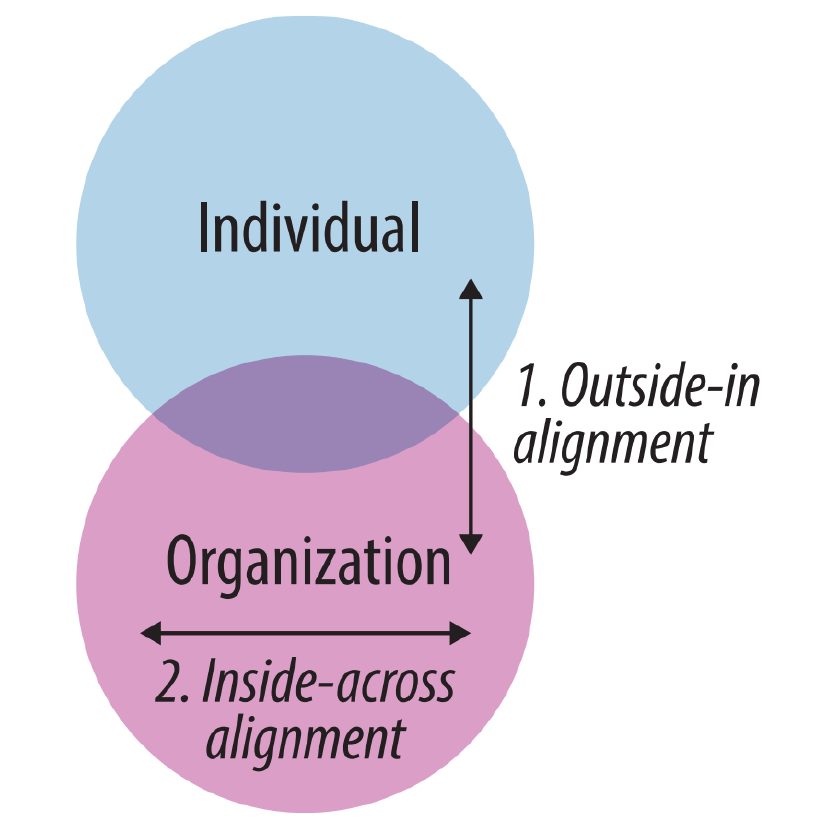
The act of mapping is a process of negotiation and shared understanding, serving as a catalyst for team alignment and insight generation. It's a dynamic exercise that, like a campfire, gathers team members for meaningful engagement, fostering the essential "inside-across" alignment for innovation and service improvement. Through this lens, journey mapping transcends being a mere deliverable to become a pivotal process in designing and delivering customer-centric services.
A step-by-step journey map activation
Journey mapping goes beyond workshops, serving as a key component of a holistic mapping strategy. Jim's book details a universal approach to creating maps like service blueprints or journey maps, involving stages of:
- initiation (scoping the project);
- investigation (basing the map on research);
- visualization (illustrating the findings);
- alignment (making the insights actionable through collaborative efforts).
This approach emphasizes transforming mapping insights into concrete strategies.
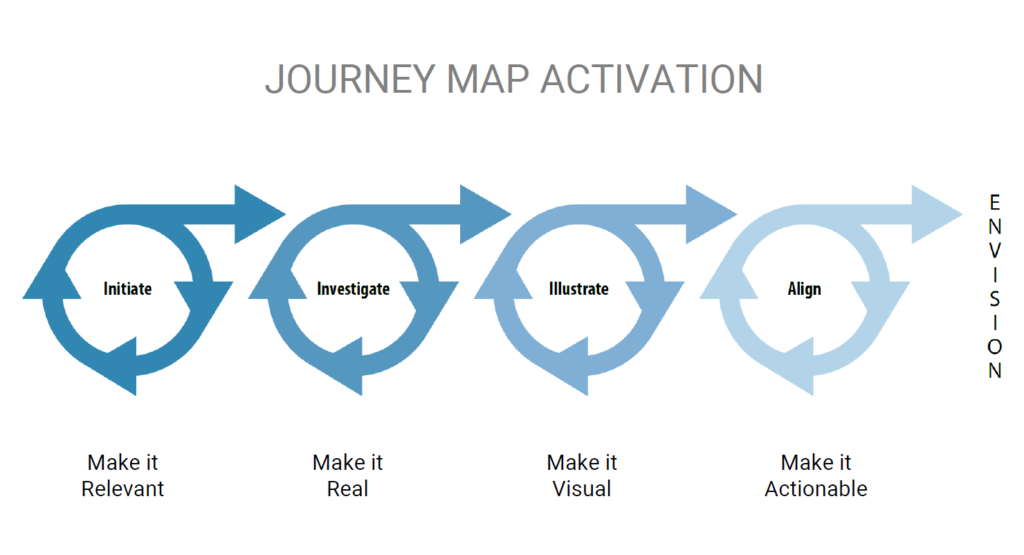
The journey mapping process is designed to deeply involve and engage the team at every step, integrating a social dimension to enhance collaboration and commitment. By focusing on making the journey map actionable and embedding team engagement from initiation through alignment, the process produces a valuable experience tool and cultivates a shared move towards practical outcomes.
Step 1. Initiate: make it relevant
In the journey mapping process, pinpointing specific customer segments and their paths is fundamental. This step, known as establishing the "point of view," involves choosing the focus — deciding which users or customers and their journeys to highlight.
It is essential to delineate the journey's scope, mark where it begins and ends, and determine the content the map will feature. These early focus, scope, and content decisions are crucial for every mapmaker.
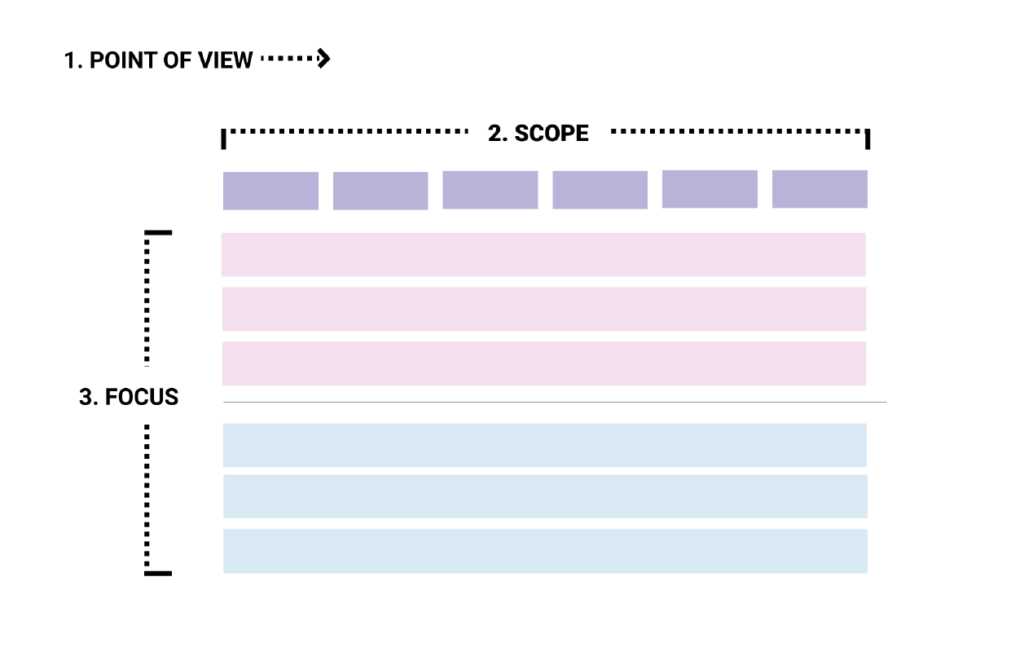
Engaging the team in these preliminary decisions ensures alignment and shared understanding. Activities like stakeholder mapping can clarify the map's domain and audience, underlining that the map's purpose is strategic insight, not mere decoration.
The journey map's primary audience is the internal team, making their involvement vital. Early discussions should identify key stakeholders and align the mapping effort with the organization’s strategic goals, enhancing the process with diverse insights.
It is a critical preparatory step to identify all relevant stakeholders — buyers, sellers, agents, etc. — and prioritize them according to business objectives when mapping the journey of home buyers in an online real estate service, for instance. Choosing to focus on home buyers and a specific aspect of their experience, like shopping for a new home, is made through collaborative team engagement. That ensures the journey map aligns with agreed priorities and organizational goals, fostering a collective sense of ownership and direction from the outset.
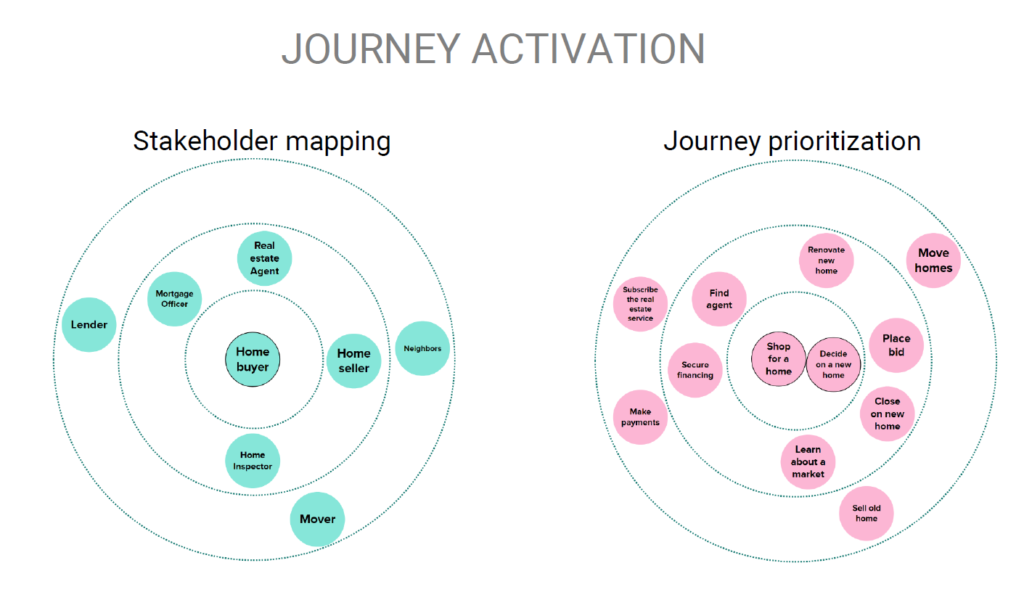
This collaborative approach to defining the mapping process's focus doesn't necessitate extensive research but can be achieved through straightforward, inclusive discussions. Continuous team engagement throughout the mapping ensures that the journey map remains relevant and aligned with the team's objectives and the broader organizational goals, preventing any later misalignment and ensuring the journey map effectively serves as a tool for strategic insight and team alignment.
Step 2. Investigate: make it real
During the investigation phase, tangible methods like ride-along interviews bring real user experiences to the forefront. Inviting team members to listen to conversations with home buyers, possibly through platforms like Zoom, offers a direct window into customer perspectives, grounding the process in reality. This approach not only enlightens team members unfamiliar with direct customer feedback but also aligns the team's understanding of customer needs.
Centering the journey mapping on home buyers' experiences is a collective decision that ensures alignment with organizational goals. Such decisions, facilitated through quick discussions or calls, aim to reflect the team's consensus on focus areas, avoiding any surprises in the journey map's later stages.
Involving stakeholders in the investigative phase, especially in activities like customer interviews, fosters a deep understanding and participation. This involvement cultivates a unified team perspective and engagement from note-taking to listening. Regular, inclusive engagement throughout the mapping process, as opposed to a single, extensive workshop, keeps the team aligned and informed.
For remote teams, sharing customer interviews within the organization thoughtfully is crucial. Maintaining interview participants' comfort while ensuring inclusivity suggests that non-active participants keep their cameras off and microphones muted, aware of the interview but not directly involved. This approach enhances the team's empathy and understanding of the customer experience, integrating real insights into the journey mapping process.
Step 3. Illustrate: make it visual
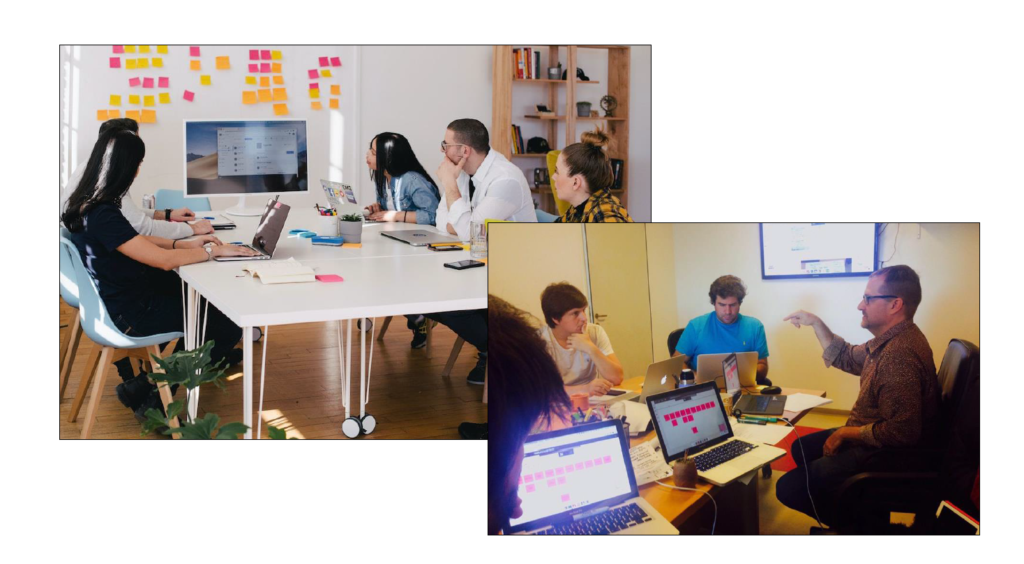
The visualization stage of journey mapping transforms insights into a tangible diagram, emphasizing collaboration in sketching and drawing. In this phase, while a mapmaker often compiles data and drafts the initial diagram, involving the entire team can deepen understanding and foster a sense of collective ownership. Active participation in creating the map, perhaps through digital platforms, encourages a shared insight and democratizes the process, making the team's collective knowledge and perspectives integral to the map's development.
This collaborative approach starts with engaging team members in the investigation phase, such as through silent observation during customer interviews on Zoom, ensuring a focused and intimate gathering of insights. Later, encouraging both team members and interviewees to contribute sketches or interpretations of the journey integrates diverse viewpoints directly into the visualization process.
Negotiating reality occurs as the team collaborates on the map's initial rough sketches, gathering stories and identifying patterns. This stage is characterized by its organic, somewhat disorganized nature, akin to a detective piecing together a case. Engaging the team in this chaotic phase demystifies the journey mapping process, illustrating that detailed, high-fidelity maps evolve from these simpler, collaborative beginnings.
Utilizing digital tools for map creation has proven effective in fostering dynamic, inclusive collaboration. It allows teams, whether remote or in-person, to co-create a map. This inclusive approach enhances the map with a rich tapestry of insights. It strengthens team alignment and ownership over the final journey map, underscoring the collective effort required to weave the gathered data into a coherent narrative.
Step 4. Align: make it actionable
The alignment phase of journey mapping shifts focus towards making the map actionable, emphasizing the importance of team collaboration to translate insights into strategic actions. That involves dedicating time for collective review and engagement with the created map through workshops that can span a few hours to a full day. These sessions integrate field insights, personas, and business needs, ensuring comprehensive understanding and alignment on the next steps.
Throughout the mapping process, embracing the initial chaos and collaboratively exploring insights is critical. Like detective work, the early stages involve identifying patterns and fostering a shared understanding. Digital tools like Mural facilitate this collaborative effort, whether conducted in person or remotely, enhancing team cohesion.
The alignment workshops serve as a platform for deep engagement with the journey map, encouraging interaction through activities like grading, voting, SWOT analysis, or role-playing. This hands-on approach ensures that the map evolves into a dynamic tool for continuous improvement rather than a static artifact.
Facilitation is crucial in this phase, bridging team perspectives with organizational goals and transforming the map into an actionable asset. Taking this step away from mere map creation towards facilitating meaningful discussions around customer experiences ensures that the journey map serves its intended strategic purpose and fosters deeper understanding and alignment within the team.
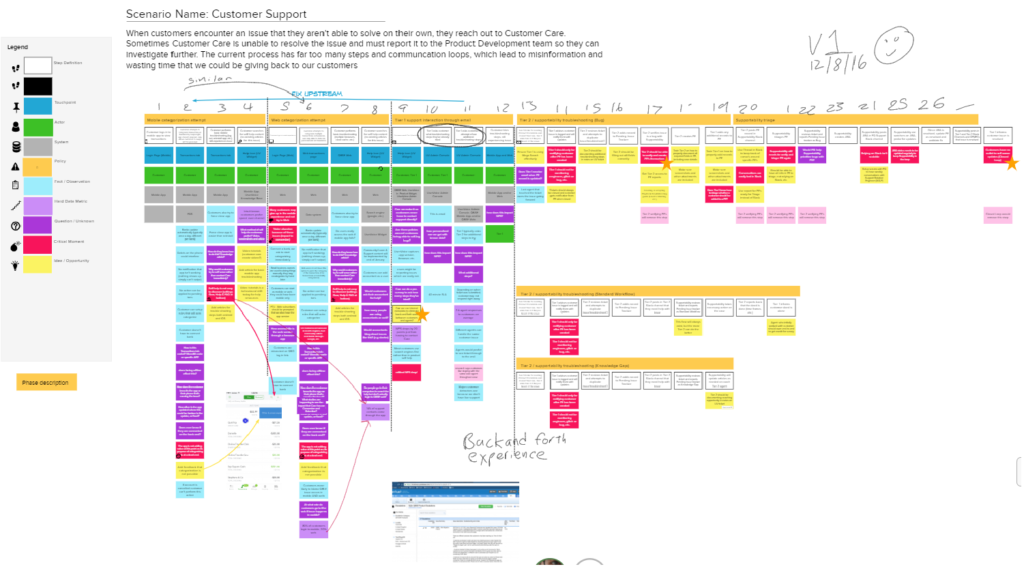
Mapping facilitation example from practice
In a collaborative digital mapping session with Intuit, Jim crafted a service blueprint enriched with visual cues and vibrant discussions. This blueprint identified key service moments, particularly a "moment of truth," derived from collective dialogue. This process demonstrated the profound value of mapping, not just in visual creation but in sparking meaningful conversations that lead to actionable insights and service improvements.
A notable session activity involved analyzing a specific customer interaction, marked by a screenshot on the map. This spurred discussions that pinpointed inefficiencies needing resolution, showcasing the dynamic interplay between visual elements and dialogue in driving toward solutions.
Further, an exercise had participants assess our company's customer support at various journey stages, revealing varied perceptions and highlighting discrepancies in service delivery understanding. This diversity in perspective prompted deeper investigations and aligned our strategic focus more closely with the customer experience.
The journey map acted as a pivotal storyboard, guiding discussions to remain customer-centric and evidence-based. Transitioning from map creation to facilitation, we employed resources like "Gamestorming" and "Innovation Games" to workshop pain points, emphasizing a design thinking approach to problem-solving that prioritizes customer needs.
The challenge extended beyond ideation to prioritizing and developing ideas into actionable solutions. Utilizing journey maps as strategic tools, the team focused on enhancing customer value, leading to rapid prototyping and usability testing to refine solutions based on real feedback. This process exemplified an efficient transition from concept to validation, ensuring solutions were grounded in genuine customer needs.
Ultimately, this mapping session underscored the importance of facilitation in driving discussions, integrating diverse insights for strategic alignment, and the need for a structured approach to transforming ideas into tangible outcomes, enhancing the overall customer journey.
Wrapping up
Journey mapping transcends the creation of a static map, becoming truly valuable through active facilitation and engagement that drives momentum. This shift from simply making a map to dynamic facilitation represents a move towards lean experimentation and continuous improvement. The map itself doesn't sustain progress; it's the proactive planning, workshops, and follow-ups that turn the mapping effort into a catalyst for innovation.
This approach challenges the traditional view of a map as a finished product, transforming it into a living tool that promotes understanding, collaboration, and actionable insights. It aims to ensure the journey map is fully integrated into strategic operations, preventing it from becoming mere "wallpaper" and instead serving as a springboard for ongoing development and team alignment.
Event recording
Want to hear it all with your ears? Watch (here's the paradox) the recording of the event that formed the basis of this article:
About the speaker
Jim Kalbach is a noted author, speaker, and instructor in innovation, design, and the future of work. He is currently the Chief Evangelist at Mural, the leading online whiteboard.
Jim is the author of several books: Designing Web Navigation (O’Reilly, 2007), Mapping Experiences, 2nd Ed. (O’Reilly, 2020), and The Jobs To Be Done Playbook (Rosenfeld, 2020). In 2023, he co-authored Collaborative Intelligence (Wiley, 2023) with Mariano Battan. Jim is also the Co-founder and Principal of the JTBD Toolkit, an online resource with learning, training, and content.





